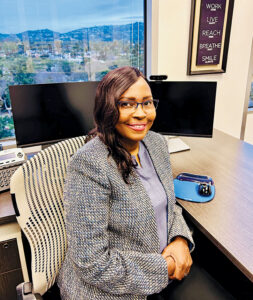CNO Roundtable 2024
Question 6: Connecting With Nurses
What are your most effective ways of connecting with your nurses to understand their priorities and concerns?

Wendy Cortez / Kaiser Permanente Irvine Medical Center
We have various channels for nurses to voice their concerns, including surveys that collect aggregate data about workplace trends and venues for face-to-face connection, such as staff meetings, committees, and regular rounding.
Danielle Gabele / VCMC and Santa Paula Hospital
We have 5 a.m. calls twice a month, which allow for dialogue and Q&A. However, my favorite way to connect is to go into our units and talk to the staff. I learn a lot more than I ever would in a meeting, and I can have informal discussions about what’s working and what’s not.
Anna Gonzales / Regal Medical Group
I make it a point to be approachable and create opportunities for staff to share their thoughts through team meetings, one-on-one check-ins, and an open-door policy. It’s also important to act on feedback received, demonstrating that ideas and concerns can lead to real change.
Leila Ibushi-Thompson / Adventist Health White Memorial
Rounding, attending staff meetings, and taking any opportunity to spend time with nurses provides dedicated space for open dialogue, allowing nurses to express their thoughts and share feedback.
 Maria Kariuki / California Rehabilitation Institute
Maria Kariuki / California Rehabilitation Institute
My most effective ways of connecting with staff are being a good listener and remaining approachable. Something I do to get to know my team members is to learn something about them, like the name of their dog. I also use these opportunities to share praise or feedback.
Dalarie Manda / St. John’s Regional Medical Center
Each month, I invite one RN from each department to have lunch with me. I usually prepare questions to prompt conversation, but once everyone starts talking, the questions aren’t needed. I love watching the nurses discuss challenges, and it allows me to really get to know them.
David Marshall / Cedars-Sinai
One way we accomplish this is through our shared leadership council structure, which gives nurses a voice in practice governance. We also have an online Council Action Request for Excellence (CARE) form, which allows nurses to bring forward issues affecting their practice.
Mark Mitchelson / Adventist Health Simi Valley
The best way to connect with staff is to be with staff. Force yourself to get out of the office and away from meetings, round with staff, and ensure that their concerns are being heard. Also, don’t forget night and weekend staff — they’re often overlooked.
 Cindy Naveira / USC Care & Ambulatory Services
Cindy Naveira / USC Care & Ambulatory Services
We have a regular cadence of daily tiered huddles, monthly “teatime” for all nurses, monthly or quarterly one-on-one sessions with nurse managers, and biweekly one-on-ones with directors. One-on-one meetings let me understand where each nurse wants to go and how I might help.
Jinhee Nguyen / Adventist Health Glendale
I really look forward to our CNO “coffee chats,” which are informal gatherings for day and evening shifts to come together and talk through whatever’s on their minds. The atmosphere is different from rounding, which is intentional; it’s terrific for encouraging open dialogue.
Darlene Scafiddi / Pomona Valley Hospital Medical Center
It’s important to have an open-door policy that encourages communication. My door is always open, and my team has my cellphone number. They always feel comfortable reaching out to discuss their priorities and concerns.
Michelle Sterling / Rancho Los Amigos
I place immense value on face-to-face interactions. “Meet them where they are” is the most effective means of fostering connections, so I carve out time for rounding and attending staff meetings to listen to nurses’ concerns and collaborate on solutions.
Armenui Telliyan / Ambulatory Care Network, LAC DHS
I always do my rounds and stop to talk to staff. I’ve known many of them for years, so I know about their personal and professional journeys. We’ve also resumed our in-person nurse recognition celebration, which is an amazing event that I emcee.
Joyce Volsch / Redlands Community Hospital
My preferred mode of communication is face-to-face, but I also maintain a separate email address for staff to send me comments, suggestions, and questions, which I answer individually and then discuss at the CNO forums I schedule each year for targeted groups.
Vicki White / Henry Mayo
Shared governance is key to enabling leadership to understand the concerns of nurses working on the floors. It’s important to engage with nurses on a personal and professional level so they can be more open about their thoughts and opinions.
Colleen Wilcoxen / USC Arcadia Hospital
As a leader, it’s important to be consistent, transparent, and visible, and to connect with staff on an individual basis. I take time to round, listen to the challenges of the units, and try to remove barriers so they can better care for our patients.
 Cheryl Witt Wheelock / Northridge Hospital Medical Center
Cheryl Witt Wheelock / Northridge Hospital Medical Center
You need both structured ways of communicating and also the flexibility to meet different needs. For instance, some of my direct reports need to meet with me weekly, while monthly meetings are better for others. Rounding is also important for building relationships with frontline staff.
In this Article: Leadership and Management


